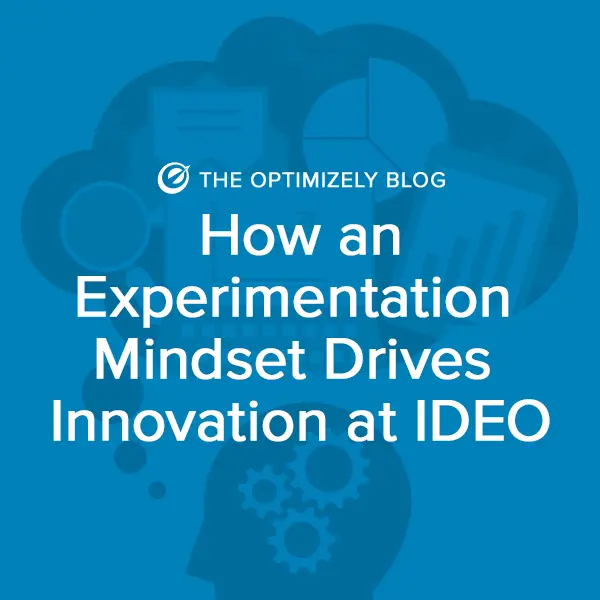How an Experimentation Mindset Drives Innovation at IDEO
Today, customers have higher expectations than they ever have before.

Julie Ritchie

A recent IBM Institute survey reported that 76% of consumers expect organizations to understand their individual needs, meaning it is increasingly important for companies to be pushing the envelope of how they’re connecting with their customers on an individual basis.
Competition is also fiercer than ever. VC firms are pumping ~$127 billion into forward-thinking companies, which means that if you and your organization are not delivering game-changing innovation and connecting with your customers, it’s quite possible that somebody else might come in and eat your lunch. Another recent report from IBM states that the number one thing that’s keeping the C-suite up at night are ‘digital invaders’.
When asked “What makes the world’s top executives cringe?” one executive said: “the ‘Uber syndrome’, where a competitor with a completely different business model enters your industry and flattens you.” Given this new reality, how can you as a company either unlock the innovation that you need in order to either fend off the competition, or actually become one of these digital invaders yourself?
We invited Whitney Mortimer, Chief Marketing Officer at IDEO—one of the world’s most innovative companies—to share some insights on how they tackle operationalizing innovation in a recent webinar. Some of the top takeaways follow below.
IDEO Culture & Innovation Methodology
IDEO is a design company, and design is really at the heart of who we are and what we do. We say that our purpose is to create positive impact through design and have disproportionate impact for a relatively small company. We’re out in the world, present in hundreds of countries at any given point in time doing research, talking to consumers and stakeholders, which is the driving force behind how we do what we do.
We design and build new ways to serve people. We help organizations innovate, and we build the new businesses and ventures that allow them to do that. We did the first mouse for Apple and other organizations. We did early laptops, we did the first smartphones. We are now working on the future of voting for LA county, the largest voting district in the country. We’re working on the future of high school in Peru, and we’re even thinking about redesigning the end of life.
The most important elements in any kind of innovation methodology are these two factors:
- Multidisciplinary teams – staffed with what we call ‘T-shaped’ people. The vertical part of the T is the depth of your craft. You may be an engineer and an MBA and potentially you are also an architect, or just one or two of those things. The horizontal part of the T is the degree to which you can collaborate with others through empathy. You can put the very best skilled people in a room, but if they don’t have top of the T cross stroke in their ability to work with each other, then it’s very difficult for that team to operate as a multidisciplinary team.
- An approach grounded in human-centered design – we borrowed from the toolkit of designers to have repeatable activities that we can use over and over again in order to make progress with regard to innovation. We believe that everyone is creative, or at least everyone was creative at some point. We also deeply believe that creative organizations are more agile. They move faster against challenges, be they small or even large existential threats.
Design Thinking
So what is creativity? Very simply stated, it’s the capacity to have, embrace, and execute against new ideas continually. We call this design thinking—which fundamentally is the set of activities that support creativity and innovation i.e. the things that we do over and over again in service of innovation.
Creative confidence is fundamentally the mindset that we’re looking for that enables creativity and innovation. It’s a worldview, it’s a stance, it’s a belief in oneself, and it’s a belief in one’s organization, that even when you get stuck or paralyzed that there is a way to move through. You need to consider 3 factors when you’re approaching any challenge:
- People: how is what I’m going to create desirable to people?
- Business: in what ways is it viable?
- Technical Requirements: is this feasible?

In many cases, there’s a tendency to want to start with the technical, because technology is moving so fast and provides so many opportunities. We believe that you always need to start with the needs of people when it comes to thinking and working like a designer, and there are different ways of impacting those needs.
First is listening and watching with empathy. It sounds easy, it’s not. For example, if you think of journey of a patient in an emergency room, can you truly view through the lens the of patient to understand everything that you may experience?
In the old evaluative and predictive model, I would have asked people what they think through surveys or in focus groups. But those findings from a generative point of view can be distorted. So what we’re often doing is trying to get inside their minds. What are they feeling? What are they actually doing? Those cues can reveal so much more than if you just rely on cognitive responses to research.
With research, instead of looking at the middle of the bell-shaped curve (i.e. where your market is), we’re also often looking at the edges, the extreme users. If you’re going to talk to people about footwear, don’t go talk to people who love footwear or who love shoes, go talk to a foot fetishist. Perhaps extreme, but ultimately will allow for thinking that pushes the boundaries of what’s possible.
Turning Research into Ideas You Can Test
Experimentation comes to life in the form of prototyping at IDEO. Prototypes are a learning opportunity to create a small experiment that we can put in front of people to solicit feedback, which is where the learning comes from. Prototypes can vary from the very rough, very crude, in the early stages of the process to those increasingly refined as we move through the process of diverging and converging.
Prototypes take many forms, and there are versions that are exploratory, versions that are inspirational, versions that are validating, and then there are versions that you create in order to test different scenarios. When you’re about to go to market, you need something that’s highly refined, and almost precisely works like, looks like the final thing.
Good guidelines for effective prototyping: rough, rapid, basically right. Every prototype is trying to solve for pretty much one, at most, two questions. You are not going to be able to solve for everything, so you want to create prototypes very quickly to start to explore successive questions.
A rule we have at IDEO is to “Never go to a meeting without a prototype.” Show me, let me experience something. If you go in with one idea perfectly baked, the only response can be, “love it” or “don’t like it.” When armed with a couple of prototypes, the conversation becomes more, “What works? What doesn’t work? What can you tell me about what would make this better?” That will become a learning opportunity for both, and builds a habit of developing a natural exchange of information that help to advance your ideas.
